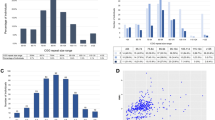Abstract
Fragile X syndrome, the most common form of inherited mental retardation, is caused by hyperexpansion and hypermethylation of a CGG repeat tract in the 5’ untranslated region of the FMR1 gene. This methylation causes the gene to be transcriptionally silenced. In addition to the common allele form with less than 41 repeats, there are two other allelic forms of the FMR1 gene that are unmethylated: premutation (61–200 CGG repeats) and intermediate (41–60 CGG repeats). Recently, premutation-specific phenotypes not related to fragile X syndrome have been reported: a 20-fold increased risk for premature ovarian failure (POF) among female carriers and an increased risk for a tremor ataxia syndrome (TAS) primarily among older male carriers. At the molecular level, increased levels of FMR1 transcript have been observed among premutation carriers. Increased levels of transcript may be causally related to the POF or TAS phenotypes or may be a surrogate of some other allelic property. In this report, we have examined the distributional properties of transcript levels by repeat size and gender among 238 individuals. We have confirmed a significant linear relationship between transcript level and repeat size in males and females. The evidence for the linear effect is primarily within the premutation size alleles.






Similar content being viewed by others
References
Ashley CTJ, Wilkinson KD, Reines D, Warren ST (1993) FMR1 protein: conserved RNP family domains and selective RNA binding. Science 262:563–566
Beever C, Lai BP, Baldry SE, Penaherrera MS, Jiang R, Robinson WP, Brown CJ (2003) Methylation of ZNF261 as an assay for determining X chromosome inactivation patterns. Am J Med Genet 120A:439–441
Brown WT, Houck GE, Jeziorowska A, Levinson FN, Ding X, Dobkin C, Zhong J, et al (1993) Rapid fragile X carrier screening and prenatal diagnosis using a nonradioactive PCR test. JAMA 270:1569–1575
Brunberg JA, Jacquemont S, Hagerman RJ, Berry-Kravis EM, Grigsby J, Leehey MA, Tassone F, Brown WT, Greco CM, Hagerman PJ (2002) Fragile X premutation carriers: characteristic MR imaging findings of adult male patients with progressive cerebellar and cognitive dysfunction. Am J Neuroradiol 23:1757–1766
Crawford DC, Acuna JM, Sherman SL (2001) FMR1 and the fragile X syndrome: human genome epidemiology review. Gen Med 3:359–371
Feng Y, Zhang F, Lokey LK, Chastain JL, Lakkis L, Eberhart D, Warren ST (1995) Translational suppression by trinucleotide repeat expansion at FMR1. Science 268:731–734
Fu YH, Kuhl DP, Pizzuti A, Pieretti M, Sutcliffe JS, Richards S, Verkerk AJ, Holden JJ, Fenwick RGJ, Warren ST (1991) Variation of the CGG repeat at the fragile X site results in genetic instability: resolution of the Sherman paradox. Cell 67:1047–1058
Galvao R, Mendes-Soares L, Camara J, Jaco I, Carmo-Fonseca M (2001) Triplet repeats, RNA secondary structure and toxic gain-of-function models for pathogenesis. Brain Res Bull 56:191–201
Greco CM, Hagerman RJ, Tassone F, Chudley AE, Del Bigio MR, Jacquemont S, Leehey M, Hagerman PJ (2002) Neuronal intranuclear inclusions in a new cerebellar tremor/ataxia syndrome among fragile X carriers. Brain 125:1760–1771
Hagerman RJ, Hagerman PJ (2002) The fragile X premutation: into the phenotypic fold. Curr Opin Genet Dev 12:278–283
Hagerman RJ, Leehey M, Heinrichs W, Tassone F, Wilson R, Hills J, Grigsby J, Gage B, Hagerman PJ (2001) Intention tremor, Parkinsonism, and generalized brain atrophy in male carriers of fragile X. Neurology 57:127–130
Jin P, Zarnescu DC, Zhang F, Pearson CE, Lucchesi JC, Moses K, Warren ST (2003) RNA-mediated neurodegeneration caused by the fragile X premutation rCGG repeats in Drosophila. Neuron 39:739–747
Kenneson A, Zhang F, Hagerdorn CH, Warren ST (2001) Reduced FMRP and increased FMR1 transcription is proportionally associated with CGG repeat number in intermediate-length and premutation carriers. Hum Mol Genet 10:1449–1454
Meadows K, Pettay D, Newman J, Hersey J, Ashley AE, Sherman SL (1996) Survey of the fragile X syndrome and the fragile X E syndrome in a special education needs population. Am J Med Genet 64:425–433
Rosser TC, Johnson TR, Warren ST (2002) A cerebellar FMR1 riboCGG binding protein. Am J Hum Genet (Suppl) 71:507
Sherman SL (2000) Premature ovarian failure in the fragile X syndrome. Am J Med Genet 97:189–194
Tassone F, Hagerman RJ, Taylor AK, Gane LW, Godfrey TE, Hagerman PJ (2000a) Elevated levels of FMR1 mRNA in carrier males: a new mechanism of involvement in fragile X syndrome. Am J Hum Genet 66:6–15
Tassone F, Hagerman RJ, Chamberlain WD, Hagerman PJ (2000b) Transcription of the FMR1 gene in individuals with fragile X syndrome. Am J Med Genet (Semin Med Genet) 97:195–203
Tassone F, Hagerman RJ, Taylor AK, Mills JB, Harris SW, Gane LW, Hagerman PJ (2000c) Clinical involvement of the protein expression in individuals with the FMR1 premutation. Am J Med Genet 91:144–152
Tilley WD, Marcelli M, McPhaul MJ (1989) Characterization and expression of a cDNA encoding the human androgen receptor. Proc Natl Acad Sci USA 86:327–331
Willemsen R, Hoogeveen-Westerfeld M, Reis S, Holstege J, Severijnen LWFN, Nieuwenhuizen IM, Schrier M, Unen L van, Tassone F, Hoogeveen AT, Hagerman PJ, Mientjes EJ, Oostra BA (2003) The FMR1 CGG repeat mouse displays ubiquitin-positive intranuclear inclusions; implications for the cerebellar tremor/ataxia syndrome. Hum Mol Genet 12:949–959
Acknowledgements
The authors thank Fuping Zhang and the laboratory of Stephen T. Warren for technical assistance, Michael Epstein for statistical discussions, and Darlene Swowimo, Ieasha Edwards, Mary L. Leslie, Elizabeth H. Scott, Gloria Novak, Lisa Shubeck, Johnnie Brown, and Amy Sullivan for recruitment of samples. This work was funded by NIH HD29909-HD35576 and CRC US DHS NIH MO-1-RR-00039.
Author information
Authors and Affiliations
Corresponding author
Rights and permissions
About this article
Cite this article
Allen, E.G., He, W., Yadav-Shah, M. et al. A study of the distributional characteristics of FMR1 transcript levels in 238 individuals. Hum Genet 114, 439–447 (2004). https://doi.org/10.1007/s00439-004-1086-x
Received:
Accepted:
Published:
Issue Date:
DOI: https://doi.org/10.1007/s00439-004-1086-x




